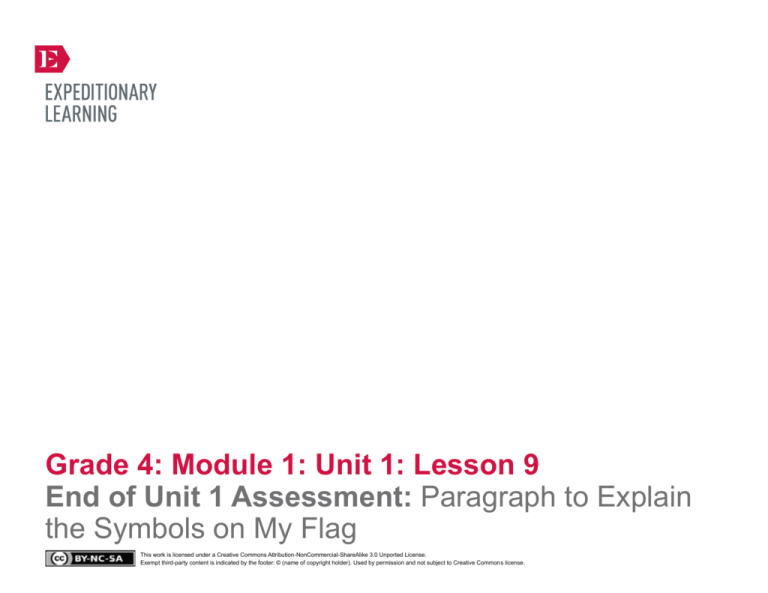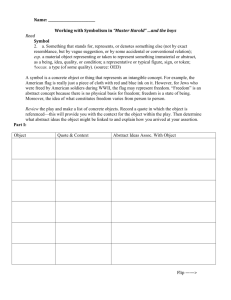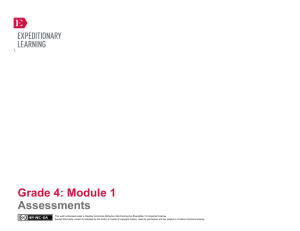
Grade 4: Module 1: Unit 1: Lesson 9
End of Unit 1 Assessment: Paragraph to Explain
the Symbols on My Flag
This work is licensed under a Creative Commons Attribution-NonCommercial-ShareAlike 3.0 Unported License.
Exempt third-party content is indicated by the footer: © (name of copyright holder). Used by permission and not subject to Creative Commons license.
GRADE 4: MODULE 1: UNIT 1: LESSON 9
End of Unit 1 Assessment:
Paragraph to Explain the Symbols on My Flag
Long-Term Targets Addressed (Based on NYSP12 ELA CCLS)
I can write an informative/explanatory text. (W.4.2)
I can engage effectively in a range of collaborative discussions with diverse partners on fourth-grade topics. (SL.4.1)
Supporting Learning Targets
Ongoing Assessment
• I can write a paragraph to inform the reader about the symbolism in my flag.
• End of Unit 1 Assessment: On-demand paragraph
explaining symbols in the flag designed for the
classroom
• I can speak clearly to ask and answer questions about our class flags.
• Creating a Flag for Our Classroom (homework from
Lesson 8)
Agenda
Teaching Notes
1.
• In advance: Review Hosted Gallery Walk protocol (Appendix 1)
Opening
A. Engaging the Writer (5 minutes)
2. Work Time
• Score students’ assessments based on the criteria you have generated with them throughout this unit. See also
the NYS 4-point rubric for extended response
A. End of Unit 1 Assessment (30 minutes)
B. Hosted Gallery Walk (20 minutes)
3. Closing and Assessment
A. Debrief and Celebration (5 minutes)
4. Homework
Copyright © 2013 by Expeditionary Learning, New York, NY. All Rights Reserved.
NYS Common Core ELA Curriculum • G4:M1:U1:L9 • June 2013 •
1
GRADE 4: MODULE 1: UNIT 1: LESSON 9
End of Unit 1 Assessment:
Paragraph to Explain the Symbols on My Flag
Lesson Vocabulary
Materials
gallery walk
• Creating a Flag for Our Classroom (completed student homework from Lesson 8)
• End of Unit 1 Assessment: On-Demand Paragraph Writing
• Masking tape
• Sticky notes
Opening
Meeting Students’ Needs
A. Engaging the Writer (5 minutes)
• Tell students that you are so proud of the work they have done learning to write good paragraphs. You are wondering how
they would do writing a paragraph all on their own. On this last day of this unit, they will be taking an assessment. Share the
purpose of the assessment with the class: “I can write a paragraph to inform the reader about the symbolism in my flag.”
Emphasize that their paragraphs will need to include a topic sentence, supporting details, and a concluding sentence, just as
they practiced with their postcard paragraph to Tim.
• On-demand assessments give the
teacher valuable information about
skills that students have mastered
or those that still need to be
developed.
• Inform students that this is an independent task and they should do their personal best work. Preview the Four-Square
graphic organizer they will complete for this assessment as it is slightly different from the one they just did. Check with
students to be certain that they understand the task.
• If students did not complete the Creating a Flag for Our Classroom homework assignment and bring in a completed
flag, provide one for them. The drawing should include at three least very obvious symbols. Students may need to talk it over
with you in order to understand the symbols before they can write about it.
Copyright © 2013 by Expeditionary Learning, New York, NY. All Rights Reserved.
NYS Common Core ELA Curriculum • G4:M1:U1:L9 • June 2013 •
2
GRADE 4: MODULE 1: UNIT 1: LESSON 9
End of Unit 1 Assessment:
Paragraph to Explain the Symbols on My Flag
Work Time
Meeting Students’ Needs
A. End of Unit 1 Assessment (30 minutes)
• Distribute End of Unit 1 Assessment: On-Demand Paragraph Writing sheet and blank Four-Square graphic
organizer.
• ELLs and other students may benefit
from extended time, a bilingual
glossary or dictionary, and a separate
testing location.
• Ideally, allot as much time as students need to perform the assessment (this may mean some students do not participate in
the Hosted Gallery Walk).
B. Hosted Gallery Walk (20 minutes)
• Divide participants into groups of five. Students will share their flag and paragraph summaries with the other four in their
group. Flags and summaries may be taped to a wall or shared in a cluster of desks.
• Students should take turns being presenters within the group. Each person should talk about their flag, perhaps by reading
their paragraphs, with 2–3 minutes for each sharing/reading.
• After each person has shared his or her flag and writing, at least three members of the group should ask a question about
the flag, such as: “Why did you choose blue?” or “Can you say more about this symbol?”
• When all five members of a team have shared and had their peers ask questions, debrief:
* How did it feel to talk about your work in a small group?
* Were the members of your group good listeners? Give evidence.
* Did your group members ask good questions? Give evidence.
Copyright © 2013 by Expeditionary Learning, New York, NY. All Rights Reserved.
• This strategy offers participants an
opportunity to share information
with others in a gallery walk–type
setting. The protocol involves smallgroup collaboration, while making
individuals responsible for the
learning and the teaching.
• When ELLs are asked to produce
language, consider providing a
sentence frame to assist with
language production and the
structure required.
• Peers providing feedback supports
others in their learning.
NYS Common Core ELA Curriculum • G4:M1:U1:L9 • June 2013 •
3
GRADE 4: MODULE 1: UNIT 1: LESSON 9
End of Unit 1 Assessment:
Paragraph to Explain the Symbols on My Flag
Closing and Assessment
Meeting Students’ Needs
A. Debrief and Celebration (5 minutes)
• Checking in with learning targets helps
students self-assess their own learning.
• Gather students together as a whole group and have them Think-Pair-Share to the following prompts:
* What was the most interesting flag you saw during the Hosted Gallery Walk?
* What should we do with our class flags now?
* What was your individual responsibility today? Did you meet your responsibilities?
• Spend time congratulating the students on their hard work in this unit. Let them know if you plan to actually send the
postcards to Tim!
• Tell students they have learned a great deal about one important aspect of Iroquois life, the Great Law of Peace. Next
they are going to learn more about how the Iroquois lived long ago and how some members of the Iroquois nation live
today.
Homework
Meeting Students’ Needs
None
Copyright © 2013 by Expeditionary Learning, New York, NY. All Rights Reserved.
NYS Common Core ELA Curriculum • G4:M1:U1:L9 • June 2013 •
4
Grade 4: Module 1: Unit 1: Lesson 9
Supporting Materials
This work is licensed under a Creative Commons Attribution-NonCommercial-ShareAlike 3.0 Unported License.
Exempt third-party content is indicated by the footer: © (name of copyright holder). Used by permission and not subject to Creative Commons license.
GRADE 4: MODULE 1: UNIT 1: LESSON 9
End of Unit 1 Assessment:
On-Demand Paragraph Writing
Name:
Date:
Directions: You are a writer and a flag designer. After researching the history of the Iroquois flag and reading about the
creation of the Iroquois Confederacy, you have created a classroom flag to show the same ideas of peace and unity. First,
complete the Four-Square graphic organizer on the next page about the symbols on your flag. Then write a paragraph in which
you explain how the symbols in your flag represent peace and unity.
Copyright © 2013 by Expeditionary Learning, New York, NY. All Rights Reserved.
NYS Common Core ELA Curriculum • G4:M1:U1:L9 • June 2013 •
6
GRADE 4: MODULE 1: UNIT 1: LESSON 9
End of Unit 1 Assessment:
On-Demand Paragraph Writing
Name:
Date:
First symbol on your flag:
Second symbol on your flag:
Details (Describe the symbol. What does it symbolize?
How does it connect to the Iroquois flag?
Details (Describe the symbol. What does it symbolize? How
does it connect to the Iroquois flag?)
Topic Sentence:
Third symbol on your flag:
Conclusion
Details (Describe the symbol. What does it symbolize?
How does it connect to the Iroquois flag?)
Copyright © 2013 by Expeditionary Learning, New York, NY. All Rights Reserved.
NYS Common Core ELA Curriculum • G4:M1:U1:L9 • June 2013 •
7
GRADE 4: MODULE 1: UNIT 1: LESSON 9
End of Unit 1 Assessment:
On-Demand Paragraph Writing
Write your paragraph here. Be sure to include the following in your writing:
• A main idea (a topic sentence explaining what your flag represents)
• Supporting details (a description of each symbol on your flag)
• A clear explanation of what each symbol represents
• A concluding sentence
Copyright © 2013 by Expeditionary Learning, New York, NY. All Rights Reserved.
NYS Common Core ELA Curriculum • G4:M1:U1:L9 • June 2013 •
8









